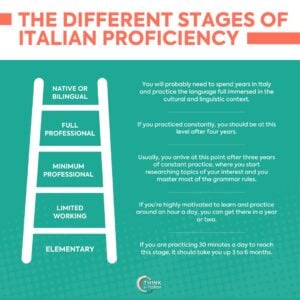How to say need in Italian: avere bisogno di and bisognare
The English verb “need” is often translated in Italian with either the impersonal verb bisognare or the verbal expression avere bisogno di: avere + bisogno + di + noun/verb.
Let’s take a closer look at the differences between the two.
Bisognare: meaning, when to use and examples
Bisognare is exclusively used as an impersonal verb (meaning that it does not need a grammatical subject).
It exists just in simple tenses (simple future, simple conditional, etc..) and is used only in the third person singular: bisogna.
An infinite verb always follows it when the subject is not identified.
Let’s look at some sentences to see when it’s suitable to use the verb bisognare.
- To express a need or an obligation for some action to be performed when there is no subject (it refers to a general rule or something that applies to everyone).
In this case, bisognare is followed by a verb in the infinitive form:
Bisogna fare silenzio al cinema durante il film.
It is necessary to be quiet at the cinema during the movie.
- To express a need or an obligation for some action to be performed when a subject is determined. In this case, bisognare is followed by che + subjunctive
Bisogna che gli studenti si impegnino di più.
It is necessary that the students work harder.
Avere bisogno di: meaning, when to use and examples
The verbal expression avere bisogno di can be broken down as follows:
The verb avere: it is conjugated as usual according to the mood and tense which fit the sentence
+ the noun bisogno
+ preposition di
+ a noun that indicates the object or person that is needed or a verb in the infinitive form that indicates the action that needs to be performed.
Note on the verb avere: like other frequently used verbs, avere is an irregular verb, meaning that it does not follow the same pattern as other second conjugation verbs and presents many different forms for each tense.
Note on the preposition di: when di is followed by a verb (in the infinitive form), it is always left as is.
For nouns, instead, it might be left as is or conjugated according to the noun immediately following it.
It is left as is if the noun requires no article or if it requires an indefinite article. It is conjugated if the noun requires a definitive article.
In that case, one of the following seven forms is used: del, dello, dei, degli, della, delle, or dell’.
Avere bisogno di: Examples
How to use bisogno in Italian?
How to say “I need” in Italian?
Let’s look at some sentences to see when it’s suitable to use the expression avere bisogno di.
- With a noun, to express the need for something (physical)
Ho bisogno di una macchina nuova.
I need a new car.
- With a noun, to express the need for something (abstract or metaphorical)
Noi abbiamo bisogno del tuo aiuto.
We need your help.
- With a verb, to express the need to do something
Ho bisogno di fare una vacanza.
I need to go on a vacation.
- With the pronouns me/te/lui/lei/noi/voi/loro.
Hai bisogno di me?
Do you need me? (= do you need my help?)
Practice with Quizlet
Here's a set of flashcards and quizzes to practice this grammar topic.Need in Italian: what to remember?
If you’re looking for how to say “need” in Italian, you have two options: the impersonal verb ‘bisognare’ or the verbal expression ‘avere bisogno di.
When using ‘bisognare‘, it’s exclusively used as an impersonal verb (meaning it doesn’t need a grammatical subject) and only exists in simple tenses (like simple future and simple conditional).
It’s always used in the third person singular: ‘bisogna’, and it’s usually used to express a need or an obligation for some action to be performed.
The expression ‘avere bisogno di’ is broken down into the verb ‘avere’, the noun ‘bisogno’, and the preposition ‘di’.
The verb ‘avere’ is conjugated according to the mood and tense of the sentence, and the preposition ‘di’ can be left as is or conjugated depending on the noun that follows it.
This expression is used to express the need for something physical, the need for something abstract or metaphorical, or the need to do something.
We hope this helps you better understand the difference between these two ways of saying “need” in Italian!




















3 Responses
That was truly useful. Thank you
Bene 🙂
Hi Ann R,
I’m glad to hear you found the lesson on how to express “need” in Italian useful. It’s always great to see students like you making progress and finding value in our content. If you have any more questions or need further clarification on any aspect of the Italian language or culture, don’t hesitate to ask. We’re here to help!